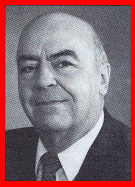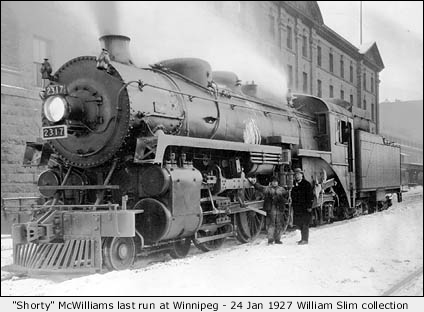Vol. 18 No. 4
April, 1988
|
Make Tomorrow Happen
|

The Tourism
Railway
Situation
|

Omer Lavallee
Corporate Historian
Emeritus
|

The Superintendent congratulates "Shorty McWilliams" upon arrival at
Winnipeg, Manitoba, on the occasion of his last run on 2317 - 24 Jan 1927 Photographer
unknown.
Several columns ago, we were talking
about museums and the preservation of railway equipment. This month, I would like to air some of my concerns about
operating tourist railways.
Most such operations in North America are not "museums" at all. What they are is more difficult to define.
At the risk of over-simplification, I suggest that sponsors of such organizations are, at heart, model
railroaders in full scale.
The operation of locomotives and cars in a roughly traditional theme differs only in size from the more traditional
hobby-railroader who is content to go down to his basement or up to the attic to create his own
"empire" in O, HO, N, or other scales.
However, while the traditional model (or, properly, "miniature") railroader can realize his ambitions
within the confines of his pocketbook (not forgetting "trackage rights" from the home-maker
half of the team!), the operators of the full-sized variety have to depend upon a larger constituency
to meet the greatly-increased costs of acquisition, restoration, maintenance, and operation of
prototype locomotives and cars.
That source is the generally-uncritical public, which makes up about 95 percent of the patrons of
tourist railways. The balance comprises active rail fans.
The public sees the operation as an amusement park with vague historical overtones. The rail fan's focus is on the
motive power. It is not characteristic of either element to be critical of the historical accuracy of the operation,
as long as there is nostalgia, some sort of "ride", plenty of steam and smoke (or diesel exhaust), and much
whistling and bell ringing.
Keep Operations Realistic, Economical
Thus, most such operations are only "historical" in the sense that they utilize and demonstrate operation
of non-current technology and equipment. I say "most" because there are a few very creditable
exceptions to this generalization, which will be treated in a later column.
While one usually finds little to criticize in the mechanical condition of the motive power or rolling stock, too
often the trains are made up of historically-improbable consists bereft of sensitivity to prototype
graphics.
Inspiration seems to be drawn largely from the paint schemes of circus trains, with bright yellows, bright reds and
silver the most popular colours. This ignores the real railways' historical and practical preference for restrained
but tasteful earth colours as dark greens, deep reds, maroons, or browns for body colours, and black or mineral brown
for roofs.
The real challenge for their sponsors is to keep such operations within realistic, economical limits. Once again
using the miniature railroad analogy, there is always a tendency to seek to expand the length of line operated,
increase the number of trains in use simultaneously or the number of units of motive power and rolling stock
available for operation.
Although tourist railways can draw on many persons with all sorts of areas of specialization - mechanical,
operations, administrative, marketing, and public relations, the one specialist in short supply in such projects is
an economist.
While one hears constantly of new projects to take over unused or abandoned lines 50, 100, and even 200 kilometres in
length, the business fact of life for a self-supporting tourist line is that "small is
beautiful".
A short main line requires less investment in capital and maintenance, not only of track and structures but also of
motive power and rolling stock.
Shorter Runs Appeal to Greater Clientele
The shorter runs offer more departure opportunities to appeal to a broader clientele. The casual passengers, who make
up 95 percent of the clientele, especially those with children, will more readily patronize a short (30 to
60-minute) ride, rather than a longer one. Those lines which are self-supporting are
seldom more than 10 kilometres in length.
Eastern Canada's steam-operated tourist railway, the Salem & Hillsborough in New Brunswick and
several other non-subsidized lines in the United States, such as the Strasburg and East Broad Top
railroads in Pennsylvania, and the Conway Scenic in New Hampshire, to mention a few of those with which this writer
is familiar, obey these precepts. Some lines are even shorter.
The intramural railway at Calgary's Heritage Park is slightly more than one kilometre in length (with no less than
three on-line stations), while the Halton County trolley museum at Rockwood, Ontario, has a length of
less than two kilometres.
One does not have to look far afield for an example of imprudence in over-expansion. The
"Steamtown" operation of Scranton, Pennsylvania, which has a large collection of Canadian steam
locomotives, is currently in financial difficulties principally because of poor economic planning for its tourist
train run.
As a result, heavy losses have been sustained and the 1988 operating schedule has been cancelled.
It is to be hoped that several other such projects currently "waiting in the wings" will avoid these
mistakes.
This CP Rail News article is copyright
1988 by the Canadian Pacific Railway and is reprinted here with
their permission. All photographs, logos, and trademarks are the property of the Canadian Pacific Railway
Company.
|